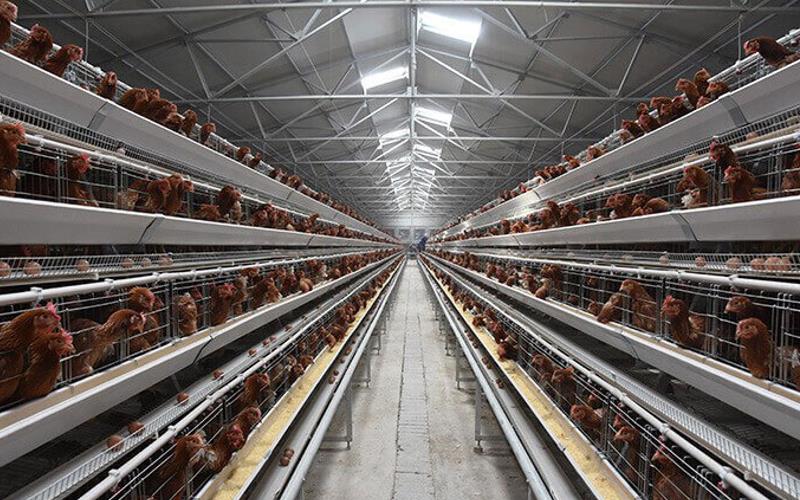Selecting the right battery cage system is a critical decision for any poultry farmer in Ghana. It directly affects your farm’s productivity, investment cost, labor needs, and long-term profitability. With several capacity options available, it can be difficult to determine which system is best suited for your specific operation.
This article will help you evaluate the most common battery cage sizes—such as 5,000-bird (5K) and 50,000-bird (50K) systems—and provide guidance based on key operational factors like farm size, budget, growth plans, and management capacity.

Understanding Battery Cage Systems
Battery cage systems are layered metal structures used to house layer hens in a controlled and efficient manner. They are widely adopted in commercial egg production due to their ability to:
- Optimize space usage,
- Improve egg collection processes,
- Enhance feed and water management,
- Reduce disease transmission through better hygiene,
- Decrease labor requirements when automated.
Battery cage systems in Ghana are increasingly used by small, medium, and large-scale poultry farms as the demand for eggs and poultry products continues to rise.
Common Battery Cage Sizes and Their Applications
1. 5K (5,000-bird) Battery Cage Systems
This is one of the most popular options for small and medium-sized farms in Ghana.

Best suited for:
- New poultry farmers,
- Smallholder farms or cooperatives,
- Farms with limited land or budget.
Key features:
- Requires approximately 150–250 square meters of space,
- Can be managed manually or with basic automation,
- Lower initial investment cost,
- Modular design allows for future expansion.
Recommendation:
A 5K system is ideal if you are just starting out or want to test the market before committing to larger infrastructure. It offers flexibility, affordability, and manageable daily operations.
2. 10K–20K Battery Cage Systems
This capacity range is a step up for growing farms moving toward semi-commercial or regional supply operations.

Best suited for:
- Mid-sized farms looking to scale up,
- Farmers supplying to local markets, retailers, or schools,
- Businesses with consistent demand and access to moderate capital.
Key features:
- Requires 300–600 square meters of space,
- Supports semi-automated feeding and watering systems,
- Balanced investment vs. production output,
- Allows for structured business growth without immediate full automation.
Recommendation:
Choose a 10K–20K system if you already have market access and plan to expand production in the near future.
3. 50K (50,000-bird) Battery Cage Systems
These large-capacity systems are intended for industrial and fully commercial poultry farms.

Best suited for:
- Large-scale egg producers,
- Farms with national distribution or export goals,
- Investors and agribusinesses with long-term ROI expectations.
Key features:
- Requires over 1,000 square meters of space,
- Fully automated systems: feeding, egg collection, waste removal,
- High upfront investment with long-term profitability,
- Designed for efficiency, labor savings, and consistent output.
Recommendation:
Select a 50K system only if you have the land, capital, and operational capacity to manage a high-output, fully automated production environment.
Factors to Consider When Choosing a Cage Size

To make the best decision, consider the following five factors:
- Bird Population Goals
How many layers do you plan to raise within the next 12–24 months? Choose a system that fits your current flock and allows for future growth. - Farm Size and Infrastructure
Do you have enough space for the system? Will you need to construct new buildings or modify existing ones? - Labor and Management
Do you have trained workers to manage manual feeding and egg collection? Or do you prefer automation to reduce labor costs? - Budget and Access to Financing
Can you afford a large system upfront, or is it better to begin with a smaller investment and scale gradually? - Market Demand and Business Model
Are you supplying local households or commercial buyers? The scale of your operation should match your market size and pricing strategy.
Our Guidance for Ghanaian Poultry Farmers
For most small and medium farms in Ghana, a 5K battery cage system is the most practical starting point. It requires modest capital, is easier to manage, and can be expanded as your business grows.
For medium-scale farms aiming for steady regional supply, a 10K or 20K system offers a strong balance of cost and output.
For farms with established markets and access to capital, a 50K system enables maximum productivity and long-term efficiency, especially when paired with full automation.

Conclusion
There is no one-size-fits-all answer when it comes to battery cage systems. The best option depends on your farm’s size, budget, labor force, and long-term goals. What’s most important is choosing a system that is sustainable, scalable, and aligned with your business strategy.
If you’re still unsure which size is right for your operation, speak with an experienced equipment supplier who understands the Ghanaian poultry sector.
Get Expert Help Choosing the Right Battery Cage System
We supply a full range of high-quality poultry farming equipment, including:
- Galvanized battery cages from 5K to 100K+ bird capacity,
- Manual, semi-automatic, and fully automatic systems,
- Local installation support across Ghana,
- Spare parts, technical guidance, and after-sales service.
To request a quote or free consultation, contact us through the form below or message us directly WhatsApp(8615090085057). Let us help you choose the battery cage system that will support your farm’s success.






